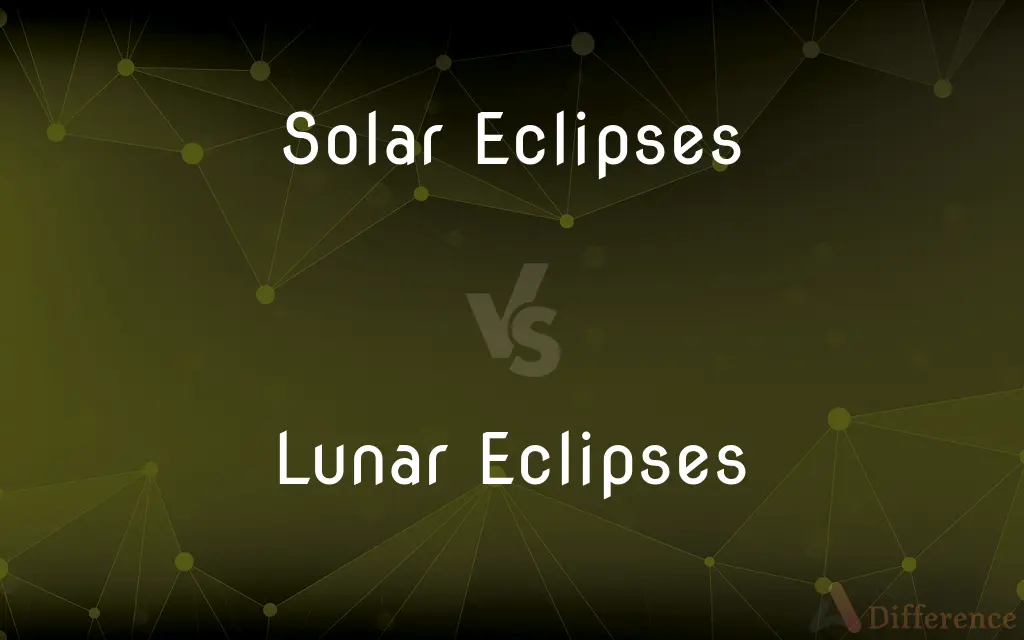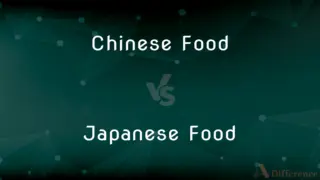Solar Eclipses vs. Lunar Eclipses — What's the Difference?
By Urooj Arif & Fiza Rafique — Published on May 19, 2024
Solar eclipses occur when the Moon passes between the Earth and Sun, blocking sunlight, whereas lunar eclipses happen when Earth casts its shadow on the Moon, visible at night.

Difference Between Solar Eclipses and Lunar Eclipses
Table of Contents
ADVERTISEMENT
Key Differences
Solar eclipses are a daytime phenomenon, requiring the Moon to be positioned directly between the Earth and the Sun, leading to either partial or total obscuration of the Sun's light. On the other hand, lunar eclipses occur at night when the Earth lies directly between the Sun and the Moon, casting a shadow that can fully or partially obscure the Moon.
During a solar eclipse, observers within the path of the Moon's umbra experience a total eclipse, witnessing the Sun's corona, while those in the penumbra see a partial eclipse. Conversely, during a lunar eclipse, the entire night-side of Earth can observe the event, with the Moon appearing in shades of red due to Earth's atmosphere scattering sunlight.
Solar eclipses require viewers to use special eye protection to safely observe the event due to the Sun's harmful rays. Whereas, lunar eclipses can be safely viewed with the naked eye, offering a more accessible viewing experience to a wider audience.
The frequency of solar eclipses in any given location on Earth is less compared to lunar eclipses, which can be seen more often globally. This is because the area affected by the Moon's shadow on Earth is relatively small, while the shadow cast by Earth on the Moon during a lunar eclipse is larger, making it visible from anywhere on the night-side of Earth.
The cultural and historical significance of both phenomena varies, with solar eclipses often being seen as more dramatic and, historically, more ominous or foreboding, while lunar eclipses have been viewed with fascination and awe, inspiring numerous myths and legends.
ADVERTISEMENT
Comparison Chart
Occurrence Time
Daytime
Night-time
Visibility
Partially in a narrow path, total in a very small area
Globally on the night-side of Earth
Safety
Requires protective eyewear
Can be viewed safely with the naked eye
Frequency at a Given Location
Less frequent
More frequent
Astronomical Alignment
Moon between Earth and Sun
Earth between Sun and Moon
Viewing Experience
Sun's corona visible during totality
Moon appears red due to Earth's atmosphere
Cultural Significance
Often ominous or foreboding
Inspires awe, myths, and legends
Compare with Definitions
Solar Eclipses
Occurs somewhere on Earth about every 18 months.
The next solar eclipse is eagerly anticipated by astronomers.
Lunar Eclipses
Can be total, partial, or penumbral.
The partial lunar eclipse subtly shaded part of the Moon.
Solar Eclipses
Can be total, partial, or annular, depending on the alignment.
We traveled to witness the total solar eclipse.
Lunar Eclipses
More frequent visibility at any given location than solar eclipses.
The astronomy club hosts viewings for each lunar eclipse.
Solar Eclipses
Requires special glasses for safe observation.
Schools distributed solar glasses for the eclipse viewing.
Lunar Eclipses
Visible from anywhere on Earth's night-side.
The lunar eclipse was observed by millions globally.
Solar Eclipses
A phenomenon where the Moon blocks the Sun's light from reaching Earth.
During the solar eclipse, the day momentarily turned into night.
Lunar Eclipses
Does not require protective eyewear to view.
Families gathered outside to view the lunar eclipse.
Solar Eclipses
Observed during the day when the Moon passes directly between the Earth and the Sun.
The solar eclipse was visible at 10 AM.
Lunar Eclipses
Occurs when the Earth's shadow falls on the Moon.
The lunar eclipse gave the Moon a reddish tint.
Common Curiosities
What causes a solar eclipse?
A solar eclipse occurs when the Moon passes between the Earth and Sun, blocking all or part of the Sun's light.
Can lunar eclipses be viewed with the naked eye?
Yes, lunar eclipses can be safely observed with the naked eye.
How can I safely view a solar eclipse?
Viewing a solar eclipse requires special protective eyewear to prevent eye damage.
How often do solar eclipses occur?
Solar eclipses occur about every 18 months, but their visibility from a specific location on Earth is less frequent.
Can solar eclipses occur at night?
No, solar eclipses are strictly daytime events because they involve the Sun being obscured by the Moon.
Why does the Moon turn red during a lunar eclipse?
The red color during a lunar eclipse is due to Earth's atmosphere scattering sunlight and projecting it onto the Moon.
How long can a lunar eclipse last?
A total lunar eclipse can last up to several hours from beginning to end, including partial phases.
What causes a lunar eclipse?
A lunar eclipse happens when the Earth comes between the Sun and Moon, casting a shadow on the Moon.
Do eclipses have any effects on Earth?
Eclipses have minimal physical effects on Earth but can influence animal behavior and have been significant in cultural contexts.
Are lunar eclipses more common than solar eclipses?
Lunar eclipses occur more frequently in terms of global visibility compared to solar eclipses.
What is the difference between a total and partial eclipse?
A total eclipse completely obscures the celestial body, while a partial eclipse only covers a portion.
What equipment do I need to observe a lunar eclipse?
No special equipment is needed to observe a lunar eclipse; it can be viewed with the naked eye.
Can solar and lunar eclipses happen back to back?
Solar and lunar eclipses often occur in pairs, with a lunar eclipse happening two weeks before or after a solar eclipse.
Why are solar eclipses rarer to observe than lunar eclipses?
Solar eclipses are rarer to observe from any given location on Earth because the Moon's shadow only covers a small area.
What is an annular solar eclipse?
An annular solar eclipse occurs when the Moon covers the center of the Sun, leaving a ring-like appearance.
Share Your Discovery

Previous Comparison
Chinese Food vs. Japanese Food
Next Comparison
Zinc Picolinate vs. Zinc ChelateAuthor Spotlight
Written by
Urooj ArifUrooj is a skilled content writer at Ask Difference, known for her exceptional ability to simplify complex topics into engaging and informative content. With a passion for research and a flair for clear, concise writing, she consistently delivers articles that resonate with our diverse audience.
Co-written by
Fiza RafiqueFiza Rafique is a skilled content writer at AskDifference.com, where she meticulously refines and enhances written pieces. Drawing from her vast editorial expertise, Fiza ensures clarity, accuracy, and precision in every article. Passionate about language, she continually seeks to elevate the quality of content for readers worldwide.













































